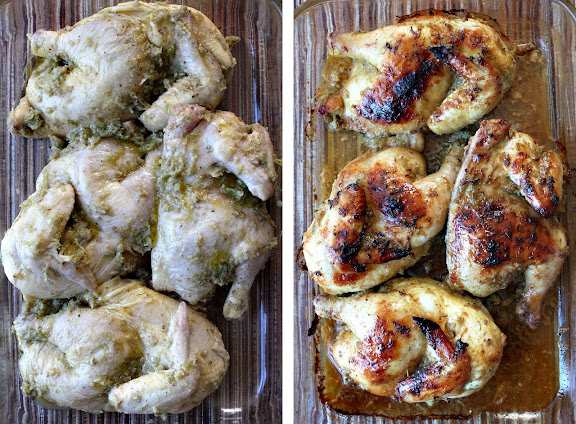
On the (by no means exhaustive) list of composite ingredients commonly used in Thai cooking which I’ve mentioned in this CNN article is this basic aromatic paste comprising fresh garlic, white peppercorns, and cilantro roots that is used in various dishes, most notably as part of a marinade. This represents one of the basic things that, once incorporated into your repertoire, will make Thai cooking much easier and more intuitive to you.
Is this all the Thai people use to marinate things? No. Is this the sacred marinade without which all Thai meat dishes are declared unrighteous? Of course not. I don’t think there ever was a council of Thai culinary gurus who got together at one point in our history and came up with a “we believe” document in the manner of Nicaea. But if you look closely at the various marinades used in traditional Thai dishes, you’ll see that these three ingredients represent what most, if not all, of these marinades have in common.
Identifying the common threads and presenting them in isolation help make things clearer to those who seek to understand how Thai food works. At least, I think so.
Your marinade can contain salt or fish sauce as the source of salinity or even soy sauce or oyster sauce which represent the Chinese influence; it may contain a sweetener which could be palm sugar, coconut sugar, cane sugar, or even honey. Other herbs, spices, or flavor enhancers can also be added to your marinade as appropriate. But, as mentioned above, most, if not all, variations contain this trinity of Thai marinade in varying amounts.
Fans of Thai-style grilled or fried chicken or grilled pork on skewers would want to acquaint themselves with this three-ingredient aromatic paste.

Take this baked cornish game hens for example. I’ve made these for years and I don’t even have a recipe. Each time I make them, they taste different depending on what other flavorings I add to the marinade. But every time it all starts with a paste of fresh garlic, whole white peppercorns, and fresh cilantro roots (or stems as shown in the photo since cilantro roots are trimmed off in the US supermarkets).
Even though I don’t always adhere to the ratio of 2 parts peeled garlic, 2 parts chopped cilantro stems or roots, and 1/2 to 1 part (depending on your heat tolerance) whole white peppercorns, in general, this is what I prefer. You may like something slightly different. Play around with different ratios to figure out what best suits your taste. For those who live in Thailand, it’s important to note that your main garlic cultivar is much, much more potent than that found in North America which I use. Therefore, you may want to reduce the amount of garlic to only 1 part or 1.5.
All you have to do is pound the three ingredients in either a terracotta or granite mortar until you get a smooth paste. Tip: it’s easier to achieve a smooth paste in a mortar when you begin with the peppercorns, then the chopped cilantro roots, then the garlic.
For these baked cornish hens, I split two hens in half and rub them with about 1/4-1/3 cup of the aromatic paste along with some salt, a good amount of honey, and about 1/4 cup brandy or tequila (or half a can of Singha or Chang). I let them marinate for at least 2-3 hours, up to overnight. Then I bake them, uncovered, in a 375°F oven for about 40-50 minutes. Once the hens are thoroughly cooked, I broil them briefly just to get the skins beautifully charred.
See the juice that has collected at the bottom of the pan? Drizzle that over plain jasmine rice and you’ll understand why garlic, peppercorns, and cilantro roots are so loved by Thai cooks.
Other recipes that contain this basic aromatic paste:
Gai Tod: Thai-style Fried Chicken
Gai Yang Pak Tai: Southern Thai-style Grilled Chicken
Ma Haw: Sweet Pork-Peanut Paste on Fresh Pineapple
Soy-Braised Chicken Wings with Quail Eggs







13 Responses to Thai Garlic-Peppercorn-Cilantro Root Aromatic Paste